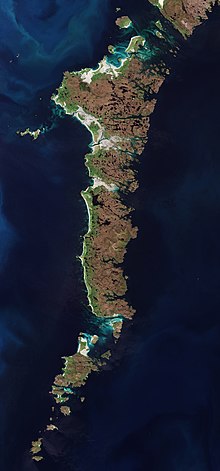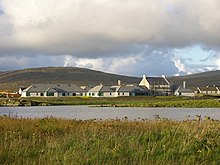|
Uist
 Uist is a group of six islands that are part of the Outer Hebridean Archipelago, which is part of the Outer Hebrides of Scotland. North Uist and South Uist (/ˈjuːɪst/ or /ˈuːɪst/; Scottish Gaelic: Uibhist [ˈɯ.ɪʃtʲ]) are two of the islands and are linked by causeways running via the isles of Benbecula and Grimsay. From south to north, the inhabited islands in the island group are Èirisgeigh (Eriskay), Uibhist a Deas (South Uist), Grimsay (South), Beinn nam Faoghla (Benbecula), Eilean Fhlodaigh (Flodaigh), Griomasaigh (Grimsay (North)), Fraoch-eilean, Uibhist a Tuath (North Uist), Am Baile Sear (Baleshare) and Beàrnaraigh (Berneray). The islands, collectively, have a population of 4,723.[1] Major settlements   The main settlements in Uist are: South Uist
Benbecula
North Uist
16th centuryGeographyWriting in 1549, Sir Donald Monro, High Dean of the Isles stated of "Ywst" that it was a fertile country full of high hills and forests on the east coast with five parish kirks. He also noted that in the north of "Ywst ther is sundrie covis and holes in the earth, coverit with heddir above, quhilk fosters maney rebellis in the countrey".[3] FishingMonro referred to the "infinite number of fresh water loches",[3] including Loch Bì, which is South Uist's largest loch and at eight kilometres (five miles) long it all but cuts the island in two. Monro stated that "the sea has gotten enteries to this fresche water loche" and described the "thicke dyke of rough staines" that had been created to prevent salt water ingress. This apparently resulted in numerous fish being caught in the stones, including "fluikes, podloches, skatts, and herings" and he described another "kynd of fishe, the quhantitie and shape of ane salmont, but it has na skaills at all; the under haffe, narrest his vombe is quhite, and the upmaist haffe narrest his back is als black as jett".[3] Land tenureMonro's description was:
See alsoBonnie Prince CharlieBenbecula was the island from which Flora MacDonald aided the escape of Prince Charles Edward Stuart (Bonnie Prince Charlie) to Kilbride, Skye in June 1746, following his defeat at the Battle of Culloden. Notes
ReferencesMonro, Sir Donald (1549) Description of the Western Isles of Scotland. William Auld. Edinburgh - 1774 edition. See alsoExternal links
|
